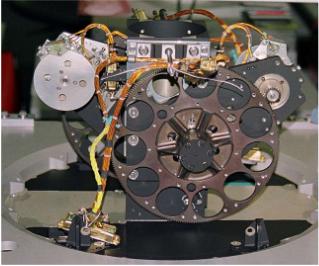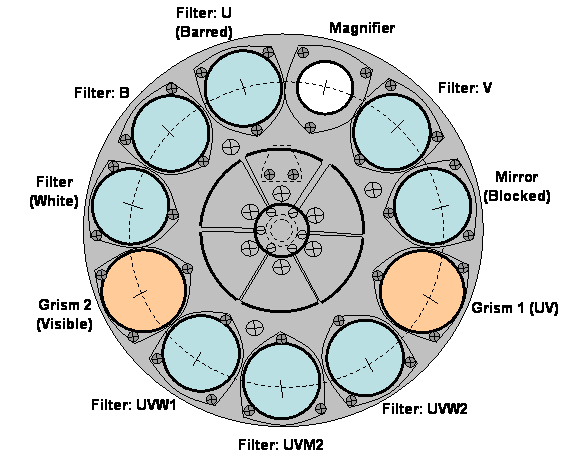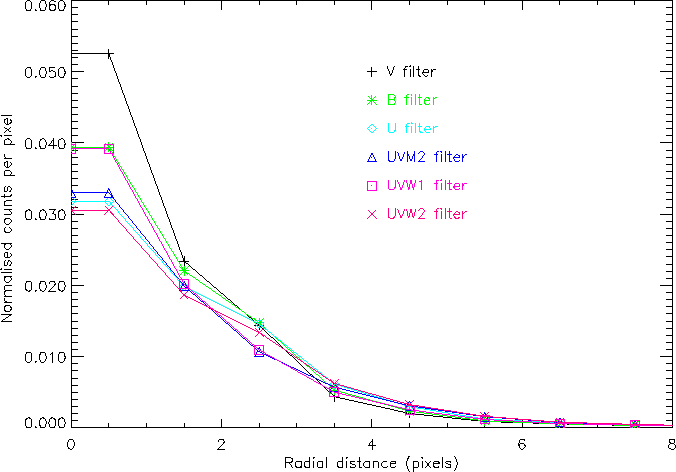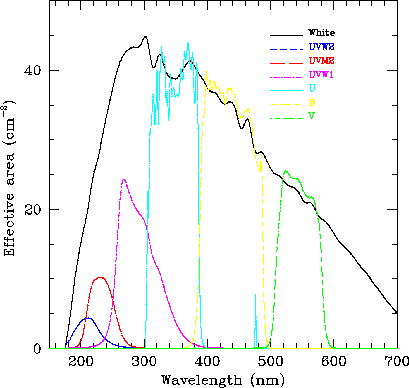 The optical monitor contains 3 types of elements: filters, grisms, and a mirror. The filters
are used to obtain optical and ultraviolet images, while the
grisms take optical and ultraviolet spectroscopic measurements. The mirror blocks light from
entering the optical monitor.
The optical monitor contains 3 types of elements: filters, grisms, and a mirror. The filters
are used to obtain optical and ultraviolet images, while the
grisms take optical and ultraviolet spectroscopic measurements. The mirror blocks light from
entering the optical monitor.
Light is reflected into the filterwheel from the inclined third mirror inside the OM baffle. Light passes through the chosen filter or grism on the filterwheel into the OM detector. For further technical details, please refer to the XMM-Newton Users' Handbook from the XMM-Newton Science Operations Centre at Vilspa.
Click on a filter name for more information.
|
0. Mirror (Blocked) 1. Filter: V 2. Magnifier (unavailable) 3. Filter U: Barred |
4. Filter: B 5. Filter (White) 6. Grism 2 (Visible) 7. Filter: UVW1 |
8. Filter: UVM2 9. Filter: UVW2 10. Grism 1 (UV) |

|
||
The mirror is used to block photons from entering the optical monitor. This is essential when the optical monitor passes through or near the light path of a bright object, such as a bright star, planet, the Sun, the Moon, or Earth.
The V filter allows optical light to pass through to the CCD with a bandpass between 500 and 600 nanometers. Zero point is 18.1071, FWHM is 1.6", and the aperature radius is 6". Assuming an A0 star spectrum, the brightness mV limit is 7.4, and the limiting magnitude is 21.4. Top
Unavailable Top
The U filter allows ultraviolet light to pass through to the CCD with a bandpass between 300 and 400 nanometers. The U filter is third in terms of maximum scientific yield of all filters on the filterwheel; only the B and UVW2 filters have higher scientific yield. Zero point is 18.2389, FWHM is 2.3", and the aperture radius is 6". Assuming an A0 star spectrum, the brightness mV limit is 7.6, and the limiting magnitude is 22.2. Top
The B filter allows optical light to pass through to the CCD with a bandpass between 380 and 500 nanometers. The B filter is first in terms of maximum scientific yield, followed by the UVW2, U, and UVW1 filters. Zero point is 19.2761, FWHM is 2.0", and the aperture radius is 6". Assuming an A0 star spectrum, the brightness mV limit is 8.5, and the limiting magnitude is 23.0. Top
The white filter allows a broad spectrum of light to pass through to the CCD with a bandpass from 180 past 700 nanometers. Top
The optical grism is a right-angled prism with a diffraction grating on the back side that allows optical light to pass through. The transmitted optical photons can be used to make spectroscopic measurements. The spectral resolution of the optical grism is 1 nm / pixel. The optical grism is blazed, so 0th order images are relatively weak compared to UV grism images. The two grisms cannot be used simulataneously. Top
The UVW1 filter allows ultraviolet light to pass through to the CCD with a bandpass between 220 and 400 nanometers. The UVW1 filter is fourth in terms of maximum scientific yield; it should be used in preference after the B, UVW2, and U filters. Zero point is 17.3716, FWHM is 1.7", and the aperture radius is 17.5". Assuming an A0 star spectrum, the brightness mV limit is 6.6, and the limiting magnitude is 21.4. Top
The UVM2 filter allows ultraviolet light to pass through to the CCD with a bandpass between 200 and 280 nanometers. Zero point is 16.0169, FWHM is 2.0", and the aperture radius is 17.5". Assuming an A0 star spectrum, the brightness mV limit is 5.2. Top
The UVW2 filter allows ultraviolet light to pass through to the CCD with a bandpass between 180 and 260 nanometers. The UVW2 filter is second in terms of maximum scientific yield; it can be used in preference after the B filter. Zero point is 15.1650, FWHM is 2.3", and the aperture radius is 17.5". Assuming an A0 star spectrum, the brightness mV limit is 4.4. Top
Grism 1 (UV) The UV grism is a right-angled prism with a diffraction grating on the back side that allows ultraviolet light to pass through. The transmitted UV photons can be used to make spectroscopic measurements. The UV grism has a spectral resolution of 0.5 nm / pixel, and the unblazed grism allows approximately one third of the light into the 0th order image. This image should be visible near the edge of the field of view. The UV grism cannot be used simulataneously with the optical grism. Top

